The Broad Breasted White turkey is a breed of domestic turkey from United States. It is commercially the most widely used domesticated turkey for meat.
The breed was actually developed by crossing the White Holland and the Broad Breasted Bronze turkey. And it has become the dominant turkey breed on the market. The breed is the one that most American are familiar with.
Before development of the breed, the Broad Breasted Bronze breed held the dominant position on the turkey market. But people began to prefer the Broad Breasted White turkey during the beginning in the 1960s.
Breeders began to prefer the breed because they produced a cleaner looking carcass.
The general white turkey breed was admitted into the American Poultry Association’s Standard of Perfection in 1874. Read some more information about this domestic turkey breed below.
Broad Breasted White Turkey
The breed was created by selectively breeding several strains of White Holland turkeys, which were known for their large size and meat quality.
The first strains of White Holland turkeys were brought to the United States in the 1800s, and were primarily raised for their meat and eggs. These birds were originally bred in Europe, and were prized for their hardiness and adaptability to a variety of environments.
In the early 1900s, turkey breeders in the United States began experimenting with breeding different strains of White Holland turkeys to create a larger, more productive breed. The goal was to develop a turkey that would produce more meat per bird, while maintaining the desirable traits of the White Holland breed.
Through careful breeding and selection, the Broad Breasted White turkey was developed. This breed was characterized by its large size, broad breast, and high-quality meat. The Broad Breasted White turkey quickly became a popular choice for commercial meat production, due to its large size and fast growth rate.
Today, the Broad Breasted White turkey is one of the most common breeds of domestic turkey in the United States. It is widely used for commercial meat production, as well as for exhibition and breeding purposes.
Despite its popularity, the breed is also known for its susceptibility to health issues due to its large size, and requires careful care and management to stay healthy and productive.
Characteristics
The Broad Breasted White turkeys are large sized birds and they have been bred for providing a meaty carcass with more breast meat than any other turkey breeds.
They are generally complete white in coloration with pink legs, a black beards, and red carnucling. The poults or baby birds are generally of yellow color.
Average live body weight of the mature Broad Breasted White turkey is between 17 and 20 kg. But sometimes they can weight more.
Size
Broad Breasted White turkeys are a large breed, with mature toms weighing up to 30 pounds and mature hens weighing up to 20 pounds. This makes them an ideal choice for commercial meat production.
Appearance
Broad Breasted White turkeys have white feathers, a pinkish-white head and neck, and a bright red wattle and snood. Their legs and feet are grayish-white.
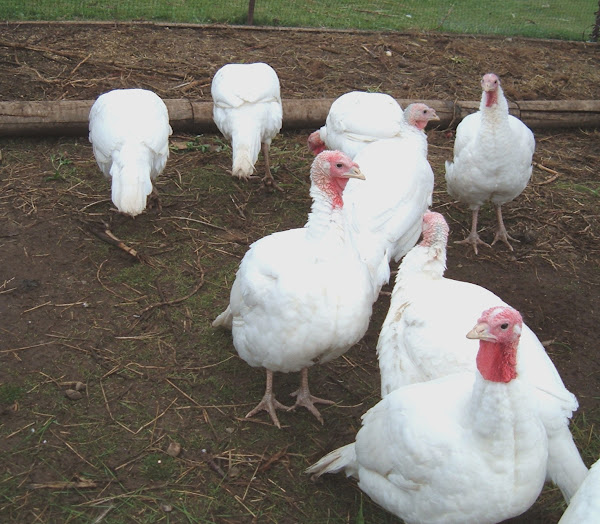
Temperament
These turkeys are generally docile and friendly, and can be easily handled with proper care and training.
Meat Quality
The Broad Breasted White turkey is known for its high-quality meat, which is tender, juicy, and flavorful. This breed is often used for commercial meat production due to its size and meat quality.
Health Issues
Due to their large size, Broad Breasted White turkeys are prone to a variety of health issues, including leg problems, heart disease, and respiratory infections. Proper care and management can help prevent these issues.
Reproduction
This breed is not known for its natural reproductive ability, and artificial insemination is often used to produce fertile eggs.
Housing
A good, secure and comfortable housing is essential for the health and well-being of these birds, as it can help protect them from the elements, provide them with a safe and comfortable environment, and prevent the spread of disease.
When it comes to housing Broad Breasted White turkeys, there are several important factors to consider. Here are some key things to keep in mind:
Space
Turkeys need plenty of space to move around and stretch their wings. Ideally, you should provide at least 10 square feet of space per bird. This can be in the form of a large barn or shed, or an outdoor enclosure with plenty of room to roam.
Ventilation
Good ventilation is crucial for keeping turkeys healthy, as it helps to remove moisture, ammonia, and other pollutants from the air. Make sure your turkey housing has plenty of windows or vents to allow for adequate airflow.
Temperature
Turkeys are sensitive to temperature fluctuations, so it’s important to keep their housing at a consistent temperature. In colder climates, you may need to provide additional heat sources such as heaters or heat lamps to keep them warm.
Lighting
Adequate lighting is important for the health and well-being of turkeys, as it helps to regulate their sleep cycles and can promote healthy growth. Provide at least 14-16 hours of light per day, and make sure the lighting is evenly distributed throughout the housing area.
Flooring
The flooring in your turkey housing should be easy to clean and provide good traction to prevent slips and falls. Many turkey farmers opt for concrete or gravel flooring, as these materials are durable and easy to sanitize.
Nesting Areas
If you plan to breed your turkeys, you’ll need to provide nesting areas for the hens to lay their eggs. Nesting boxes should be clean, dry, and lined with clean bedding such as straw or wood shavings.
Feeding
Proper feeding is essential for the health and growth of these birds, as it can provide them with the nutrients they need to thrive and produce high-quality meat.
When it comes to feeding Broad Breasted White turkeys, there are several important factors to consider. Here are some key things to keep in mind:
Protein
Turkeys require a high-protein diet to support their rapid growth and development. A good turkey feed should contain at least 20-24% protein, with a balance of essential amino acids. You can also supplement their diet with insects, worms, and other protein-rich treats.
Vitamins and Minerals
In addition to protein, turkeys require a variety of vitamins and minerals to stay healthy. Look for feeds that contain a balance of vitamins A, D, and E, as well as calcium, phosphorus, and other essential minerals.
Water
Access to clean, fresh water is essential for turkeys. Make sure to provide plenty of water sources, and clean and refill them daily to prevent contamination.
Feeding Schedule
Turkeys should be fed at regular intervals throughout the day, with smaller, more frequent meals being better than larger, less frequent meals. Provide enough feed to keep the birds satisfied, but avoid overfeeding, as this can lead to health problems such as obesity.
Free-range vs. Confined Feeding
Depending on your setup, you may choose to feed your turkeys free-range or in a confined area. Free-range turkeys can supplement their diet with grass, insects, and other natural foods, while confined turkeys may require more careful monitoring to ensure they receive all the nutrients they need.
Breeding
Breeding Broad Breasted White turkeys can be a rewarding experience, but it requires careful planning and attention to detail. Here are some key things to keep in mind if you are interested in breeding these turkeys:
Choosing Breeding Stock
Start by selecting healthy, high-quality breeding stock. Look for birds that are free of defects, have good muscle tone, and are a good weight for their age and breed.
You’ll also want to choose birds with a calm and docile temperament, as this can make breeding and handling easier.
Mating
Turkeys mate naturally, with males competing for the attention of females. It’s important to provide enough space for the birds to mate and to prevent aggression or fighting. You may also need to artificially inseminate your hens to ensure successful breeding.
Incubation
Turkeys require an incubation period of around 28 days. You can incubate eggs using an incubator or a broody hen.
Make sure to keep the eggs at a consistent temperature of around 99-101 degrees Fahrenheit, and rotate them regularly to prevent the embryos from sticking to the sides of the egg.
Hatching
Once the eggs hatch, the poults will need a warm, dry, and safe environment to grow and develop. Provide plenty of clean bedding, heat lamps or other heat sources, and a consistent supply of food and water. You may also want to separate the poults from the adult turkeys to prevent injury or illness.
Care and Management
Breeding Broad Breasted White turkeys requires ongoing care and management. Make sure to provide adequate nutrition, clean water, and a safe and comfortable environment.
You’ll also need to monitor the birds for signs of illness or injury, and treat any health issues promptly to prevent the spread of disease.
Caring
Broad Breasted White turkeys require careful care and management to stay healthy and productive. Here are some key things to keep in mind when caring for these birds:
Housing
Turkeys require a clean, dry, and well-ventilated environment. You can house them in a coop or a free-range area, depending on your setup. Make sure to provide enough space for the birds to move around and perch, and to protect them from predators and inclement weather.
Feeding
As mentioned earlier, turkeys require a high-protein diet that is balanced with essential vitamins and minerals. Provide them with a high-quality turkey feed, as well as fresh water and occasional treats like insects, worms, and vegetables.
Water
Access to clean, fresh water is essential for turkeys. Make sure to provide plenty of water sources, and clean and refill them daily to prevent contamination.
Health
Turkeys are susceptible to a variety of health issues, including respiratory infections, parasites, and injuries. It’s important to monitor your birds regularly for signs of illness or injury, and to treat any issues promptly to prevent the spread of disease.
Environment
Turkeys are social birds and thrive in a calm and stress-free environment. Avoid loud noises, sudden movements, and overcrowding, which can cause stress and lead to health problems.
Monitoring
Keeping track of your turkeys’ weight, growth rate, and overall health is important for their well-being and productivity. Keep detailed records of their feed and water intake, growth rate, and any health issues that arise.
Uses of Broad Breasted White Turkey
The Broad Breasted White turkey is a meat breed. It is largely and commercially used for meat production.
Special Notes
The Broad Breasted White turkey is the most popular and widely raised breed of domestic turkey. Today these birds are highly popular throughout the world and they are excellent for meat production.
Broad Breasted White turkey is the breed raised by the commercial turkey farmers in the United States. The breed is very good for producing breast meat.
These birds have shorter breast bones and legs than other breeds and are unable to reproduce naturally. And they must be artificially inseminated.
Today the Broad Breasted White turkeys are grown in large, fully automated grow-out barns, which may house as many as 10,000 birds.
They generally can’t flight and prone to health problems associated with being overweight, because of their size (due to excess muscle). They are prone to heart disease, respiratory failure and joint damage.
They are generally short-lived birds, and they have a very high percentage of their eggs hatch. However, review full breed profile of this turkey breed in the following chart.
| Breed Name | Broad Breasted White |
| Other Names | None |
| Breed Purpose | Mainly meat |
| Special Notes | Very strong and hardy birds, docile temperament, but some birds can become aggressive, highly dependent on selection by breeder, today raised mainly for meat production, very good for producing breast meat, very productive birds and are of large size, today highly popular throughout the world, can’t flight, short-lived birds |
| Breed Size | Large |
| Tom | Around 20 kg |
| Hen | Around 17 kg |
| Climate Tolerance | Almost all climates |
| Color | White |
| Rarity | Common |
| Country/Place of Origin | United States |
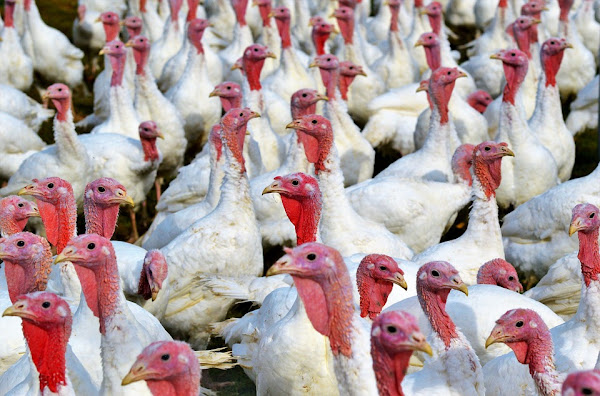
Frequently Asked Questions
People ask many questions about Broad Breasted White turkey. Here we are listing the most common questions about this turkey breed, and trying to answer them. Hope you will find your answer. Don’t hesitate to ask us if you have more questions.
Is Broad Breasted White turkey farming profitable?
Yes, commercial production of this turkey is a very profitable business. You can make good profits from this business if you can do everything perfectly. Currently, Broad Breasted White is the most common and popular breed of domestic turkey.
How to start Broad Breasted White turkey farming business?
Starting commercial production of Broad Breasted White turkey is very easy and a profitable business. You can easily start this business if you follow the steps mentioned below.
- First of all, select a very good location for your farm.
- Then make a very good house for your birds.
- Select the right breed for your business.
- Purchase birds from trusted breeder.
- Feed your birds with good and nutritious food.
- Vaccinate them timely and always provide them all required medicines.
- And always try to take good care of your birds.
How long does it take to raise a broad breasted white turkey?
The Broad Breasted White is a fast growing turkey breed. These birds generally reach slaughtering age within their 14 to 18 weeks of age.
Do Broad Breasted White turkeys lay eggs?
Yes, sure! Although, Broad Breasted White is a meat turkey breed and raised mainly for meat production purpose.
How big does a Broad Breasted White turkey get?
The Broad Breasted White is a meat turkey breed and they are generally larger in size with an average body weight of 38 to 40 lbs.
Can Broad Breasted White turkeys breed naturally?
No, they notoriously can not mate naturally, an the hens must be artificially inseminated. Actually, the Broad Breasted Whites were breed specifically to produce maximum meat. And they can not breed easily mainly because of the bulf of their hefty breasts.
How many eggs do Broad Breasted White turkeys lay?
Generally, a Broad Breasted White hen can lay around or up to 100 eggs per year.
What is the lifespan of a broad breasted turkey?
Average lifespan of a Broad Breasted White turkey is between 2 and 5 years. Although, they are not allowed to live more than 18 months in the commercial farms.
What is the color of Broad Breasted White turkey eggs?
The Broad Breasted White hens generally lay off white colored eggs.
What are the characteristics of Broad Breasted White Turkeys?
The Broad Breasted White turkeys are large sized birds and they have been bred for providing a meaty carcass with more breast meat than any other turkey breeds. They are generally complete white in coloration with pink legs, a black beards, and red carnucling. The poults or baby birds are generally of yellow color. Average live body weight of the mature Broad Breasted White turkey is between 17 and 20 kg.
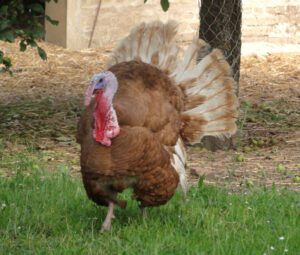
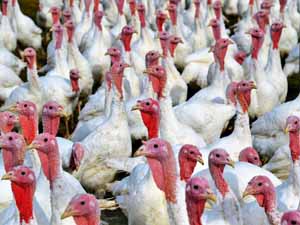
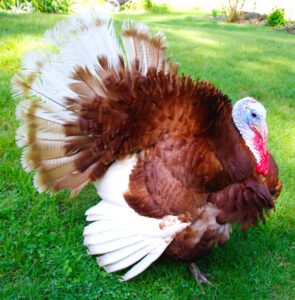

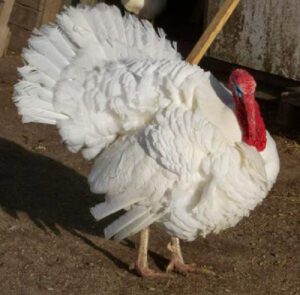
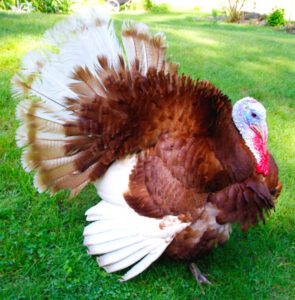
Is this breed able to lay eggs for consumption?